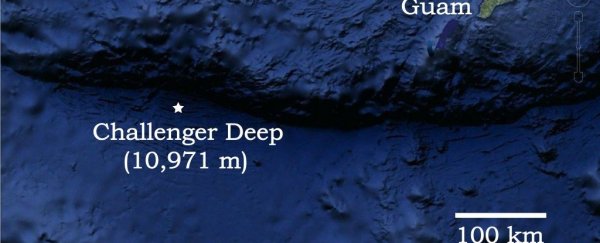Back in March 2016, scientists released the first audio recordings taken from the deepest point on Earth's surface, Challenger Deep, at the bottom of the Mariana Trench.
Filled with strange moans, low rumbles, and the occasional high-pitched screech, the soundbites below shed rare light on the dark world that lies 10.9 km (6.7 miles) below the crushing weight of the Pacific Ocean… and they're somehow both haunting and beautiful at the same time.
On the whole, we know very little about what goes on inside the Mariana Trench, located at the bottom of the Pacific Ocean around 322 km (200 miles) southwest of Guam, mostly because it's so difficult for us to get to.
But Robert Dziak, an oceanographer with the US National Oceanic and Atmospheric Administration (NOAA), figured that even if we couldn't explore the trench ourselves for long periods of time, we might be able to eavesdrop on it.
So his team dropped a titanium-encased hydrophone down to Challenger Deep, the trench's deepest point, and kept it recording for 23 days straight.
Below are some of the strange sounds that came back, including whales calls, which are made by a mix of baleen and toothed (odontocete) whales:
The first thing you'll notice is that, for somewhere with 16,000 pounds per square inch (PSI) of pressure crushing down from above, and where the Sun never shines, the deepest point on Earth is a lot noisier than you'd expect.
That's because sound waves travel an incredibly long way in water, turning Challenger Deep into something of an echo chamber for sounds from miles around.
In one of the recordings you can clearly hear the propellor of a boat travelling across the surface 10.9 km (6.7 miles) away, and another day the researchers captured the distinctive rustling of a category four typhoon raging overhead. Not to mention the frequent rumbling of earthquakes.
"I was surprised by just how cleanly we can record whales, ships, and all sorts of activity taking place at the surface," Dziak told Maddie Stone over at Gizmodo at the time.
Here's what it sounds like when a boat passes 10.9 km (6.7 miles) over your head:
And here's a magnitude 5 earthquake rumbling near Guam on 16 July 2015:
This is a baleen whale's calls right before and after the same quake:
The hydrophone was able to survive at those depths and continue recording for more than three weeks thanks to clever engineering.
"The pressure at that depth is incredible," said Haru Matsumoto, an engineer from Oregon State University who worked on the hydrophone.
"We had to drop the hydrophone mooring down through the water column at no more than five metres per second to be sure the hydrophone, which is made of ceramic, would survive the rapid pressure change."
But although the soundbites give us fascinating insight into the Mariana Trench, that wasn't the sole purpose of the mission - the NOAA is hoping to use the recordings to establish a baseline for ambient noise in the deepest part of the Pacific Ocean.
That way they can determine in future if human-created noise in the ocean is getting louder, and begin to assess how that might affect marine animals that use sound to communicate, navigate and feed, such as whales and dolphins.
Dziak is now hoping to go back to the Mariana Trench soon to do more recording, and would also love to explore the deep areas of the Arctic Ocean that are beginning to become accessible as the polar ice caps shrink.
"It is akin to sending a deep-space probe to the outer Solar System," Dziak told Gizmodo. "We're sending out a deep-ocean probe to the unknown reaches of inner space."
Contemplate that while you listen to the call of baleen whale, possibly a humpback or blue whale, echoing in the deepest place on Earth:
A version of this article was first published in March 2016.
